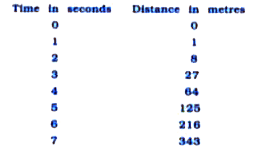Two obhects.each of masss 1.5 kg are moving in the same straight line but in opposite directions.The velocity of each object is 2.5 m before the collision during which they stick together.What will be the velocity of the combined object after collision?Solution in Gujrati
Here,
( It is moving in opposite direction.)
Let the velocity of the combined object after collision be v m
total momenta after collision
The velocity of the combined object after collision is 0m
Topper's Solved these Questions
- BOOK - KUMAR PRAKASHANCHAPTER - FORCE AND LAWS OF MOTIONEXERCISE - Additional Exercise4videos
FORCE AND LAWS OF MOTION
- BOOK - KUMAR PRAKASHANCHAPTER - FORCE AND LAWS OF MOTIONEXERCISE - Additional Numericals for Practice18videos
FORCE AND LAWS OF MOTION
- BOOK - KUMAR PRAKASHANCHAPTER - FORCE AND LAWS OF MOTIONEXERCISE - QUESTIONS AND ANSWERS(Solve the following examples/numericals :)8videos
FORCE AND LAWS OF MOTION
- BOOK - KUMAR PRAKASHANCHAPTER - GRAVITATIONEXERCISE - ACTIVITY 10.42videos
GRAVITATION
Similar Questions
The following is the distance-time table of an object in motion:

(a)What conclusion can you draw about the acceleration ?Is it constant. Increasing decreasing ir zero? (b)What do you infer about the force acting on the object?02:50View SolutionThe velocity of an object of mass 50 kg increases from 3 ms−1 to 12 ms−1. What will be the force required for this?
07:53View SolutionA constant force acts on an object of mass 5kg for a duration of 2s.It increases the object's velocity from 3 ms−1 to 7 ms−1.Find the magnitude of the applied force .Now if the force was applied for a duration of 5s,What would be the final velocity of the object ?
06:17View SolutionTake an empty plastic bottle . Close the mouth of the bottle with an airtight stopper . Put it in a bucket filled with watere . The bottle floats .
Push the bottle into the water. You feel an upward push. Try to push it further down. You will find it difficult to push deeper and deeper. Water exerts a force on the bottle in upward direction. Now release the bottle. It bounces back to the surface.
Does the force due to the gravitational attraction of the earth act on this bottle? If so, why doesn't the bottle stay immersed in water after it is released ?02:50View SolutionTwo objects each of mass 5 kg are moving in the same straight line but in the opposite direction towards each other with some speed of 3 m/s. They stick to each other after collision. What will be the velocity of the combined object after collision?
01:55View Solution20 किग्रा द्रव्यमान की एक वस्तु जो कि 10 मी/से के वेग से गतिशील है, 5 किग्रा की एक स्थिर वस्तु से टकराती है। टक्कर के बाद ये दोनों वस्तुएँ एक-दूसरे से चिपक जाती है, तो गणना कीजिए,
(i ) संयुक्त द्रव्यमान किस वेग से गति करेगा,
(ii ) टक्कर से पूर्व सम्पूर्ण निकाय की गतिज ऊर्जा कितनी थी,
(iii ) टक्कर के पश्चात निकाय की गतिज ऊर्जा कितनी है तथा
(iv ) टक्कर के पूर्व व टक्कर के पश्चात निकाय की गतिज ऊर्जा में कितना परिवर्तन आया और अनुमान लगाइए कि इस ऊर्जा का क्या हुआ ?05:01View Solutionदो वस्तुएँ , प्रत्येक का द्रव्यमान 1.5 kg है , एक ही सीधी रेखा में एक - दुसरे के विपरीत दिशा में गति कर रही हैं | टकराने से पहले प्रत्येक का वेग 2.5ms−1 है | टकराने के बाद यदि दोनों जो एक - दुसरे से जुड़ जाती हैं तब उनका सम्मिलित वेग क्या होगा ?
04:21View SolutionTwo objects each of mass 5 kg are moving in the same straight line but in the opposite direction towards each other with some speed of 3 m/s. They stick to each other after collision. What will be the velocity of the combined object after collision?
 View Solution
View Solution2 किग्रा की एक वस्तु 3 मी/से के वेग से 1 किग्रा की वस्तु पर टकराती है 1 किग्रा की वस्तु विपरीत दिशा में 4 मी/से के वेग से गतिशील है। टक्कर के पश्चात् दोनों वस्तु जुड़ जाती हैं, तब दोनों का संयुक्त वेग होगा (मी/से में)
01:42View Solution2 kg এবং 4 kg ভরের দুটি বস্তু একই সরলরেখা বরাবর এবং একই অভিমুখে যথাক্রমে 6 m/s এবং 3 m/s বেগে গতিশীল। তারা পরস্পর সংঘর্ষে লিপ্ত হল এবং সংঘর্ষের পর প্রথম বস্তুর বেগ 2m/s হলে দ্বিতীয় বস্তুর বেগ নির্ণয় করাে ।
03:07View Solution1.5 kg ভরের দুটি বস্তু একই রেখা বরাবর কিন্তু বিপরীত অভিমুখে গতিশীল । সংঘর্ষের সময় তারা পরস্পরের সঙ্গে জুড়ে যাওয়ার পূর্বে তাদের প্রত্যেকের বেগ ছিল 2.5 m / s । সংঘর্ষের পর সংযুক্ত অবস্থায় বস্তুদ্বয়ের বেগ কত হবে ?
View SolutionA 10 kg object collides with a stationary 5 kg object and after collision, they stick together and move forward with velocity 4ms−1. What is the velocity with which the 10 kg object hits the second one ?
06:21View SolutionTwo objects each of mass 5 kg are moving in the same straight line but in the opposite direction towards each other with some speed of 3 m/s. They stick to each other after collision. What will be the velocity of the combined object after collision?
View SolutionA 10 kg object collides with stationary 5 kg object and after collision they stick together and move forward with velocity 4ms−1. What is the velocity with which the 10 kg object hit the second one ?
01:55View SolutionA 10 kg object collides with stationary 5 kg object and after collision they stick together and move forward with velocity 4 ms^(-1) . What is the velocity with which the 10 kg object hit the second one?
View SolutionTwo objects m_1 and m_2 are moving in the straight line approaching each other as shown. After collisions these objects together. What will be the velocity of the combined object after collisions?
View Solution

